If you’ve ever struggled with dropped calls and slow internet service from a cell signal, you may find yourself in need of an RV cell booster.
These little pieces of equipment pack a big punch when it comes to improving your ability to stream and upload from all of your electronic devices.
What Is an RV Cell Booster?
A cell booster is actually an entire system that finds a cell signal, amplifies that signal, then broadcasts it to other devices in your car or RV. In other words, it receives a weak signal and makes it stronger.
This boosted signal can help your cell phone, cellular tablet, or internet hot spot perform much faster.
How Much Do RV Cell Boosters Cost?
Many of the most-dependable RV cell boosters cost $300 to $650. You may find a few priced lower, but you’ll generally get what you pay for in this category. Higher-priced units outperform the others in most situations.
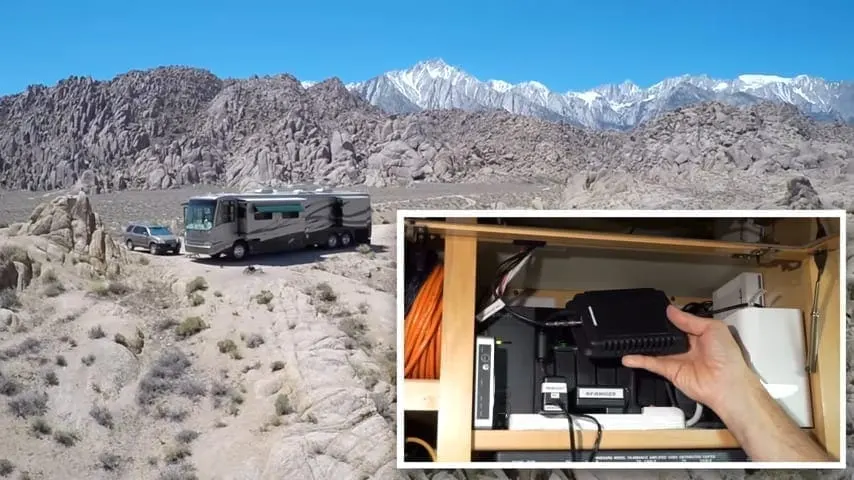
A cell booster can improve connectivity a lot, even in some pretty remote places.
And when it comes to needing a reliable internet connection or phone service, you won’t want to skimp, especially if you’re working from the road.
Reasons They’re Worth It
Here are a few of the improvements you can expect when using a reputable RV cell booster:
- You’ll experience improved safety and security on the road, as a booster can help you maintain cell service while driving, even in more remote areas.
- The booster can make unusable cell service usable, even for streaming. (You may go from one bar to three or four, for example.)
- A booster is a “must-have” for boondocking, as it can allow you to get off-grid but still stay connected.
- Because of its benefits, a cell booster can make it possible for you to work on the road, even if you find yourself in places with weak cellular signals.
RV Cell Boosters May Not Be For You
You might not require a cell booster, however, if:
- You’re not traveling much and already have good service.
- You travel primarily to urban areas where there are numerous cell towers.
- The network is bogged down – this usually happens in highly-congested areas with few cell towers, like in the Grand Tetons, or Quartzsite, AZ during the annual show. Remember, an RV cell booster can’t create a signal where there is none, and it can’t give you priority over other users when towers are crowded, either.
Our Favorite Cell Boosters
WeBoost Drive Reach RV is for maximum signal. At $500, you’ll get more bang for your buck: it offers 33% more range, and it’s 5G ready. This model is the latest, highest-power version available for RV installations (and what we would install if we were buying a new one for our RV). It comes with the booster, a high-power roof-mount omni-directional antenna, and an interior antenna that provides boosted signal to multiple devices at the same time.
- Reaches The Farthest Cell Towers And Boosts Signal For Multiple Devices.Power 50 Watts
- Compatible With All U.S. Carriers, Including Verizon, At&T, T-Mobile, And Uscellular
WeBoost Drive Sleek is a more economical option. Priced at $200, this booster is made specifically for cell phones, increasing signal strength while also charging your phone. You must place your phone or hotspot in the WeBoost cradle to receive a boosted signal, which means you can only boost a single device at a time. If you normally connect all of your other devices to either your hot spot or your cell phone via WiFi, then this is a great option for you. But if you need multiple cellular devices to be boosted at the same time (i.e. you need multiple cell phones getting strong cellular signal so more than one person can make calls), you may want to consider stepping up to the Drive Reach RV listed above.
- Stronger Cell Signal — The Weboost Drive Sleek Ensures Fewer Dropped Calls, Better Voice Quality, Faster Mobile Internet, And Improved Improved...
- Carrier Compatibility — Allows Drivers To Enjoy Stronger Cell Signal From All U.S. Networks And Carriers Including Verizon, At&T, Sprint, T-Mobile,...
Amazon’s prices are usually quite competitive, but before buying there be sure to compare the price when buying from WeBoost directly. RVgeeks viewers can save 5% on their entire order at Weboost’s online store, so it may be cheaper there! Here are the details:
We loved our original weBoost Drive 4G-X with OTR Spring-Mount Trucker antenna. But with our recent tech cabinet upgrades, we replaced it with a weBoost Drive...Show More
We loved our original weBoost Drive 4G-X with OTR Spring-Mount Trucker antenna. But with our recent tech cabinet upgrades, we replaced it with a weBoost Drive Reach RV. It keeps us connected (both voice and data) in some amazingly remote locations. We wouldn’t be “geeks” without it!
Check out the contents of our tech cabinet (2021)
Save 5% on your entire order with the discount code "RVGEEKS" (be sure to enter it in the "Discount Code" field at checkout).
Show LessNo matter your needs, an RV cell booster can help improve your experience online or on the phone, wherever cell service is available.
It’s an excellent piece of equipment to have on hand when the situation calls for some amplification, and it will give you the freedom to travel further into remote areas without giving up your connection. We wouldn’t go anywhere without ours… it’s an invaluable tool in our online connectivity toolbox.
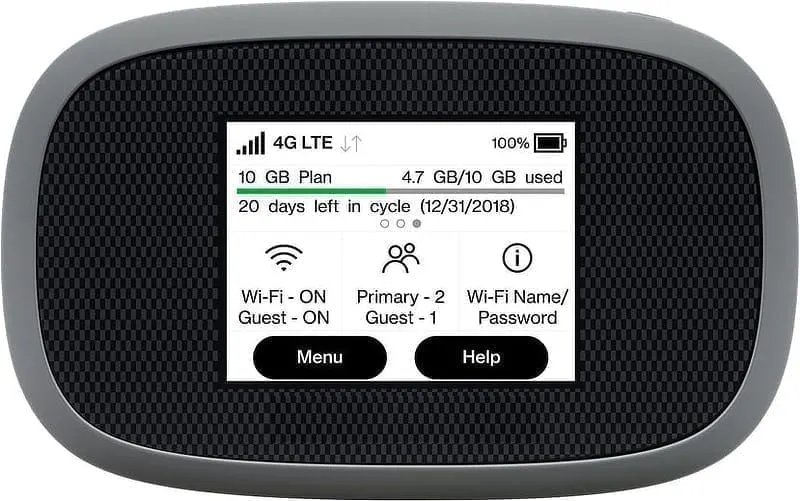
A mobile cellular hotspot device
But… if the price of a cell booster is beyond your budget, or if your travels don’t take you to places where you’re on the fringe of cell service, there’s an alternative (and less expensive) option. If you use a mobile hotspot device as your primary source of internet connection when traveling in your RV, you can (almost always) attach a small external antenna to it in order to boost the signal it receives.
This small, inexpensive antenna can be mounted to the inside of a window, aimed in the general direction of the nearest cell tower, and significantly improve your connection strength & speed.
- Improve performance of your mobile broadband devices when indoors or in, fringe zones with this portable antenna, covering a wide band spectrum...
- Usable indoors or outdoors. Frequency Bands: 700-906/1710-1990/2110-2170/2500-2700 MHz
Just note that there are a couple of points to be aware of before planning to use this as an option:
- This is NOT a booster. It’s merely a larger, directional antenna that can improve the signal strength of your device.
- Any device you want to use the Netgear MIMO with has to have external antenna ports. Most modern smartphones DON’T have them. But if you primarily use a mobile hotspot device (a dedicated device that connects to the cellular network and then broadcasts a WiFi signal for your other devices to connect to) for your internet connection, they commonly have them. The ports are usually hidden behind small covers/plugs (and are sometimes called “Test Ports” not “Antenna Ports”), so they might not be easy to spot. Just be sure to check for them before buying!
- This will only improve the cellular signal for a single device. Since it has to connect to the external antenna ports of the device, it can’t be connected to more than one at a time. With a booster like the WeBoost Drive Reach RV, you can boost signal strength for multiple devices at the same time. So you could improve the cellular data connection of your mobile hotspot AND improve the call quality of your cellphone at the same time. The Netgear MIMO only enhances the signal for one device. But if your phone & phone plan support using WiFi calling… by having a stronger cellular data connection for your hot spot device, you may also experience better quality for voice calls.
Installing a Cell Booster
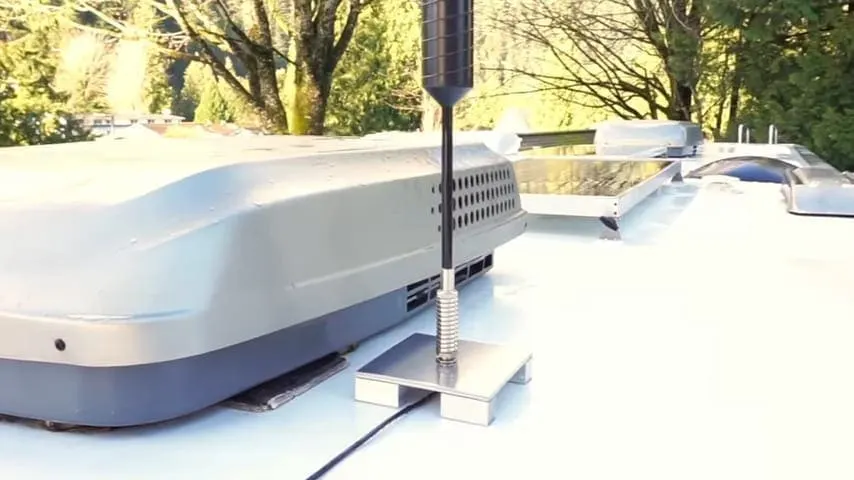
Larger cell boosting systems require antenna installation on the roof, with a cable running to the RV interior.
If you do decide to go the route of installing a cell booster, it isn’t hard, but you may have to go up on your RV’s roof. The larger boosting systems include an antenna that should be mounted on the top of your RV (with no obstructions).
These antennas have a cable that will then need to be run to the inside of the RV. This means that having an interior access point is essential (your RV’s refrigerator vent is a common spot to use for bringing wires from the roof down into the RV).
Once the antenna is mounted, and the wires are run, the rest is a breeze.
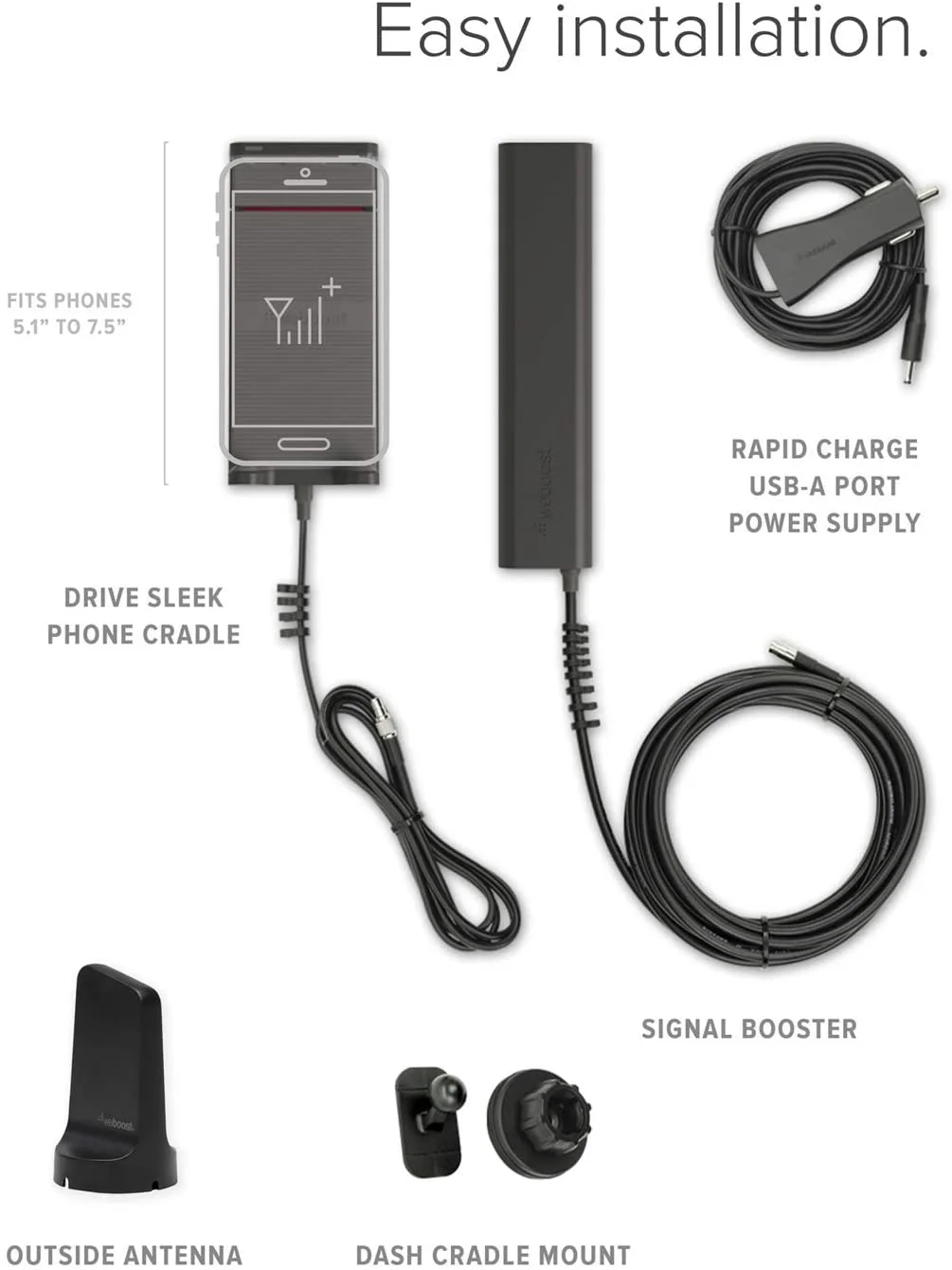 The Drive Sleek booster is created for smaller vehicles; therefore, we primarily recommend using this model for Class B and Class C RVs, or in the vehicle you tow your RV with.
The Drive Sleek booster is created for smaller vehicles; therefore, we primarily recommend using this model for Class B and Class C RVs, or in the vehicle you tow your RV with.
This smaller unit is even easier to install. That’s partly because it comes with a magnetic exterior antenna that sticks in place on the roof. But the fact that it has a magnet to mount to a metal roof is more than just an installation convenience. This antenna also needs the metal of the roof to reflect the signal from the antenna (it’s called a ground plane). Once the antenna is mounted to your vehicle’s roof, the attached wire is small enough to run through a window or door seal.
No matter which booster you choose, they include easy-to-understand instructions with images to help you through the process.
Geek Out With Us Every Week
Join our newsletter to learn about all things RV-related. Every week we offer free tips, tricks, product reviews, and more to our online community of RVers. Whether this is your first time on the road or you’re a seasoned expert, we’d love for you to geek out with us!


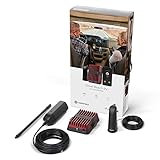



Ricardo
Monday 16th of January 2023
Hey folks. Thanks for the posts! I am almost there to get my wifi solution as I also have to work while camping. My question is: would it be able to buy just a device that I could connect to the antenna I have in my RV? It's probably those old ones used for TV signals but, it's still is an antenna and I have an internal coaxial connection inside the RV to that antenna already there. So just wondering if I'm not half way into a solution. Thanks!
TheRVgeeks
Monday 16th of January 2023
Hi Ricardo. COULD you do it? Yeah, probably. But we bet you won't see very good performance from that setup. First, the antenna isn't necessarily optimized for the frequencies used by WiFi. If TV and WiFi operated on the same frequency, they'd interfere with one another. Another reason would be that most TV antennas include an amplifier... which most likely ALSO filters out unwanted (i.e. WiFi) frequencies.
But also... this article is about cell boosters, not Wi-Fi. They're two different technologies, so be sure you know which you're going after. It gets confusing because there are cellular devices (like your phone in Hotspot mode or a portable hotspot device) that connect to the internet via cellular signal (so a cellular booster is needed to improve signal in remote areas), but then broadcast a WiFi network locally so other devices (laptops, tablets, gaming devices, etc) can connect... but since it's local and close by, you don't need a WiFi booster.
Minnie Pearl
Monday 7th of June 2021
We just purchased the WeBoost Drive Reach Kit and are ready to install. Your YouTube video from 2017 was very helpful! We want to use the VHB tape rather than putting holes in our roof, but we don't know if it will work. Our new '21 Heritage Glen 25rbhl says it has "roof W/PVC membrane. Will the tape stick to this material? It is not smooth but lightly textured. We believe the same material is used on the ends of our slide as well.
If the VHB will not work on this roof type, is it possible to mount the antenna to the side of the AC shroud or to a bath vent cover? Do you see any problems with that? We are not on the road much, but rather at spots more long-term. So we were thinking if using the shroud/cover as a mounting location, we could unscrew the antenna while we're on the road?
Thanks for all your help. Love your videos, website, newsletter, tv show...EVERYTHING! You make this full-time RV lifestyle much easier!
Bob Pauls
Saturday 6th of August 2022
@TheRVgeeks,
All VHB tapes adhere on metal, glass, and high surface energy plastics. High surface energy plastics include acrylic , ABS, polycarbonate , PVC, polyester, Polyamide, Polyimide, Phenolic, Noryl.
https://multimedia.3m.com/mws/media/764998O/iatd-product-info.pdf
TheRVgeeks
Monday 7th of June 2021
Hi Minnie! First, congrats on your new RV! We hope you're going to love it! And we're glad you asked about using the VHB tape for the weBoost antenna. Because your travel trailer has a "rubber" roof (generic term that covers multiple materials... EPDM, TPO, and PVC), it means you have a membrane that's stretched over the roof substrate and usually (though not always) adhered down to it with some glue/adhesive. Using VHB to mount the weBoost antenna down to it (the way we did with creating a mount for ours: https://www.thervgeeks.com/weboost-drive-4gx/ keeping in mind that we have a solid fiberglass roof) could result in the antenna pulling the roof membrane loose from the substrate... which could lead it to tear and cause a leak.
Unfortunately, weBoost seems determined to only provide a ladder-mount mechanism for installing their antennas. And as more and more RVs come WITHOUT ladders, it leaves owners in a bit of a pickle. Mounting it to the AC shroud or bath vent covers is likely to cause two problems:
The plastic those are made of probably isn't sturdy enough to support the antenna for very long... and is likely to crack over time. HAVING to get up on the roof to raise/lower the antenna each time you make/break camp will get old. Quickly.We can think of two options that might work best for your situation:
You may be better served by not permanently installing the outdoor antenna at all, and instead mounting it to a pole you could put up/take down as needed. Since you have a travel trailer, and not a motorhome, you're not going to be able to use the booster while driving/towing anyway... so taking it down when you roll won't be an issue. You could use one of the flagpole stands that you roll the tire of the trailer onto to hold steady, so it won't tip/blow over. And then the pole would ensure the antenna was up above roof level and had a better line-of-sight to the cell towers. You'd just have to figure out how to route the cable from the antenna into the booster unit inside. Create a mount similar to ours but that's flat on the bottom (the new weBoost antenna doesn't require the wire to come out the bottom like our original on did, anyway) and large enough that it creates a big base to distribute the "pull" of the antenna when at speed on highways, etc (like a large piece of galvanized steel sheet). You could then adhere that plate to the roof using a nice bed of Dicor... and sealing around the edge of it with a nice bead of Dicor. That way, the "pull" of it isn't as great in any one spot of the roof, so it's less likely to damage the roof membrane.Hope these make sense and/or give you some idea on how to proceed. If the above don't sound good, you may want to hit YouTube and search for WeBoost antenna mounts to see what others have done (Brian at RVwithTito had an interesting mounting option: https://youtu.be/3s44z3fzJsA ). Might give you some more ideas.
Dr..Christian Mattner
Sunday 7th of February 2021
Has anybody got experience of using such boosting equipment in Europe and UK/ for their local net providers ??
Terry
Saturday 6th of February 2021
Peter, John I am curious about your cell phone data connection. I was wondering how much bandwidth do you use? Which carrier do you use? What is you monthly bill?
Thanks Terry Phoenix
TheRVgeeks
Saturday 6th of February 2021
Hi Terry! All good questions! Our typical monthly usage varies... anywhere from about 20GB/month to about 50GB/month. We're fairly heavy users... but not as heavy as some. We're currently on an unlimited AT&T plan that we got through MobileMustHave.com that has been working great for us. It's about $150/month and is data only. We use it in a PepWave Max Transit Duo cellular router that we also got from them, in a bundle with a Poynting 7-in-1 roof antenna. We haven't even completely installed the system (it's on our "To Do List" to install & video... stay tuned), but have been loving it. Out West here, AT&T coverage has been pretty rock solid. And the PepWave router is just plain ol' reliable. We've gone for several months at a time with it just powered on, keeping us online, without ever having to think about it.
Our "backup" plan is a 20GB North American calling plan from Bell (Canada) in our iPhone (roughly $100US/month). On the RARE occasions when the AT&T plan hasn't had signal, we hotspot off our iPhone for a few days. It's been working great.
Over the years, we've had plans from just about every carrier (Verizon, AT&T, T-Mobile)... and if being connected is of utmost importance, we recommend having coverage from more than one carrier. AT&T and Verizon being the two big boys with the greatest coverage. But T-Mobile is a strong second and, depending on your travel style & destinations, can be a very viable option.
Hope this helps!